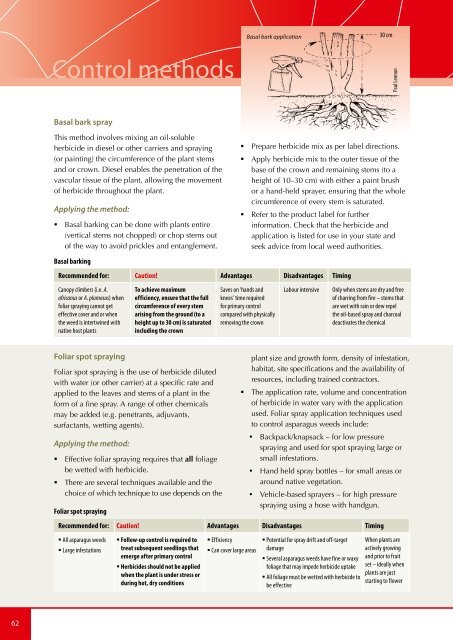Section 3. Control Methods - Weeds Australia
Section 3. Control Methods - Weeds Australia
Section 3. Control Methods - Weeds Australia
Create successful ePaper yourself
Turn your PDF publications into a flip-book with our unique Google optimized e-Paper software.
Basal bark application<br />
30 cm<br />
<strong>Control</strong> methods<br />
Paul Lennon<br />
Basal bark spray<br />
This method involves mixing an oil-soluble<br />
herbicide in diesel or other carriers and spraying<br />
(or painting) the circumference of the plant stems<br />
and or crown. Diesel enables the penetration of the<br />
vascular tissue of the plant, allowing the movement<br />
of herbicide throughout the plant.<br />
Applying the method:<br />
• Basal barking can be done with plants entire<br />
(vertical stems not chopped) or chop stems out<br />
of the way to avoid prickles and entanglement.<br />
• Prepare herbicide mix as per label directions.<br />
• Apply herbicide mix to the outer tissue of the<br />
base of the crown and remaining stems (to a<br />
height of 10–30 cm) with either a paint brush<br />
or a hand-held sprayer, ensuring that the whole<br />
circumference of every stem is saturated.<br />
• Refer to the product label for further<br />
information. Check that the herbicide and<br />
application is listed for use in your state and<br />
seek advice from local weed authorities.<br />
Basal barking<br />
Recommended for: Caution! Advantages Disadvantages Timing<br />
Canopy climbers (i.e. A.<br />
africanus or A. plumosus) when<br />
foliar spraying cannot get<br />
effective cover and or when<br />
the weed is intertwined with<br />
native host plants<br />
To achieve maximum<br />
efficiency, ensure that the full<br />
circumference of every stem<br />
arising from the ground (to a<br />
height up to 30 cm) is saturated<br />
including the crown<br />
Saves on ‘hands and<br />
knees’ time required<br />
for primary control<br />
compared with physically<br />
removing the crown<br />
Labour intensive<br />
Only when stems are dry and free<br />
of charring from fire – stems that<br />
are wet with rain or dew repel<br />
the oil-based spray and charcoal<br />
deactivates the chemical<br />
Foliar spot spraying<br />
Foliar spot spraying is the use of herbicide diluted<br />
with water (or other carrier) at a specific rate and<br />
applied to the leaves and stems of a plant in the<br />
form of a fine spray. A range of other chemicals<br />
may be added (e.g. penetrants, adjuvants,<br />
surfactants, wetting agents).<br />
Applying the method:<br />
• Effective foliar spraying requires that all foliage<br />
be wetted with herbicide.<br />
• There are several techniques available and the<br />
choice of which technique to use depends on the<br />
Foliar spot spraying<br />
plant size and growth form, density of infestation,<br />
habitat, site specifications and the availability of<br />
resources, including trained contractors.<br />
• The application rate, volume and concentration<br />
of herbicide in water vary with the application<br />
used. Foliar spray application techniques used<br />
to control asparagus weeds include:<br />
• Backpack/knapsack – for low pressure<br />
spraying and used for spot spraying large or<br />
small infestations.<br />
• Hand held spray bottles – for small areas or<br />
around native vegetation.<br />
• Vehicle-based sprayers – for high pressure<br />
spraying using a hose with handgun.<br />
Recommended for: Caution! Advantages Disadvantages Timing<br />
• All asparagus weeds<br />
• Large infestations<br />
• Follow-up control is required to<br />
treat subsequent seedlings that<br />
emerge after primary control<br />
• Herbicides should not be applied<br />
when the plant is under stress or<br />
during hot, dry conditions<br />
• Efficiency<br />
• Can cover large areas<br />
• Potential for spray drift and off-target<br />
damage<br />
• Several asparagus weeds have fine or waxy<br />
foliage that may impede herbicide uptake<br />
• All foliage must be wetted with herbicide to<br />
be effective<br />
When plants are<br />
actively growing<br />
and prior to fruit<br />
set – ideally when<br />
plants are just<br />
starting to flower<br />
62

















